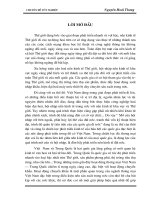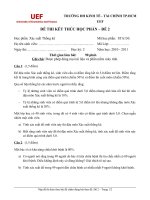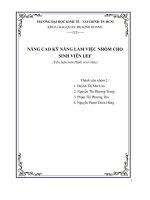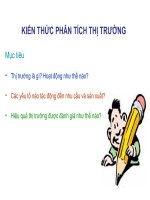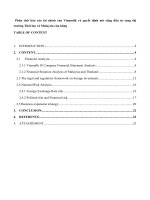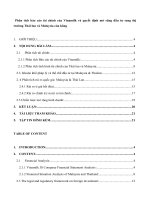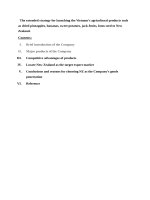UEF sẽ mở rộng sang thị trường Korea
Bạn đang xem bản rút gọn của tài liệu. Xem và tải ngay bản đầy đủ của tài liệu tại đây (773.5 KB, 28 trang )
MINISTRY OF EDUCATION AND TRAINING IN HCMC
University of Economics - Finance, HCMC
-----------------------------
INTERNATIONAL BUSINESS
TOPIC
ANALYZE AND EVALUATE THE KOREAN MARKET - THE POTENTIAL MARKET
OF THE UNIVERSITY OF ECONOMICS AND FINANCE (UEF)
LECTURER: ……………………….
SUBJECT CODE: 211.MGT1111E.B04E
MEMBERS:
1.……………………………..
2..…………………………….
3.…………………………….
4.……………………………..
5.……………………………..
6.……………………………..
International Business
Lecturer: ………………….
Table of Contents
IMAGE LISTS
2|Page
International Business
Lecturer: ………………….
A. OVERVIEW
I. Executive Summary
This topic will summary macro environment analysis including analyzing of culture,
society, economy, politics, law, technology in Korea and competitor analysis, then UEF also
carefully analyze the potentials and challenges before UEF joined enter the Korean market, and
implementation analysis: strategy, structure, operations and conclusions will be drawn in the end.
II. Overview about Korea
The Republic of Korea is the official name of South Korea however it's also referred to as
South Korea. This is often a nation within the Republic of Korea that's situated in Asia's East
Asian region and on the Choson. Seoul is the capital of this country. This busty Asian
commercial metropolis is additionally a worldwide city with a major worldwide influence. The
bulk of Korea's geography is mountainous. Mountains encompass up to 70 percent of Korea's
acreage. Additionally, Saemangeum, the world's second biggest coastal alluvium, is found on
Kim Chi's land. Korea could be a country with a high standard of living. Korea includes a
temperate climate, every year has 4 distinct seasons: Spring, Summer, Autumn, and Winter.
Koreans are friendly and disciplined and have a tendency to respect age and Moon Jae-in is the
current President of Asian country.
B. ANALISIS
I. Macro-environment analysis
1. Cultural and societal analysis
a. Cultural:
Korean culture has been greatly influenced by Chinese and Japanese cultures.
Confucianism in Korea is also influenced by China and Japan. That affluence is still preserved to
this day. For example, children in the family must respect the elderly. Honesty is a top priority in
society. Another cultural feature is that they often greet each other by bowing at a 90-degree
angle, which is different from other countries' greeting each other with a handshake. That shows
respect for the person they are talking to.
b. Societal:
Family: The research found that growing old in South Korea provided benefits for both
men and women. The highest moral precept of the parent-child relationship has always been
filial piety. It has had a significant impact on the South Korean family system. South Korean
3|Page
International Business
Lecturer: ………………….
children were (and still are) lavished with attention; toilet training was lenient, and discipline
began much later than in American households. (culturalatlas, 2021)
South Korea is a country that is well known in terms of education as it always has a very
well-educated citizenry and the ability to grasp new knowledge is also very sharp. In this
country, education is provided in both public and private schools. Both of these schools are
interested and supported by the government, but public schools are supported more than private
schools, maybe because public schools train more quality talents for the country, so they are
favored like that. With such a large talent pool, Korea is always at the top of the OECD countries
in many aspects, such as reading comprehension, mathematics, and literature.
2. Political and legal analysis
a. Political:
Due to frequent government changes, limited political freedom, and military coups, South
Korea's political history has been turbulent. In 1986, the democratic process was streamlined, the
president was given absolute power, and policymaking became simple due to the consolidated
authority. All committees are chaired by the president, making it very easy to coordinate and
operate the entire system. The United States also provides considerable political and economic
support to the country. Despite the fact that South Korea has been a democracy for almost two
decades, the military still has significant power.
b. Legal:
The South Korean legal system is modeled after that of the United States and Germany,
and trials are conducted without juries. The country is short on judges because it has an
exclusive constitutional court that oversees government decisions and lawmaking, and only a
small percentage of students pass the difficult law exams. It is a developed country, and it has an
attractive measure of industrial development.
3. Economics and trade analysis
South Korea's economic structure is well supported by government policies. South Korea
has also implemented very substantial economic reforms, as a result of which the country has
continued to prosper steadily. The country's strong export sector is the source of its economic
growth. Despite the fact that the company is well-developed in terms of overall economic health
and provides a favorable investment climate, it is nevertheless suffering from structural
4|Page
International Business
Lecturer: ………………….
weaknesses as a result of extremely strict import and FDI laws. FDIs have been dropping,
despite the fact that the country is growing economically. These constraints have an impact on
the domestic market and make it uncompetitive globally.
In 1960, Korea was one of the poorest, most difficult countries in the world, and then it
became a developed country with high turnover. That shows that Korea has made a successful
step in the economy. Overall, South Korea's overall GDP was anticipated to reach around 1.7
trillion dollars in 2019, with growth expected to continue until 2024. Along with the BRIC
countries, South Korea is regarded as one of the key economies.
In 2020:
+ services: 57% (GDP)
+ Industry: 32.8%
+ Agriculture: under 2%
- South Korea's GDP per capita was 42251.50 US dollars (2020). (trading economics, 2020)
Figure 1:The Gross Domestic Product per capital in South Korea
5|Page
International Business
Lecturer: ………………….
South Korea's unemployment rate was around 3.84 percent in 2021. (statista, 2021)
In comparison to the previous year, South Korea's average inflation rate in 2020 was at
Figure 2:South Korea's unemployment rate from 2016 to 2026
0.54%
Figure 3:South Korea: Inflation rate from 1986 to 2023
6|Page
International Business
Lecturer: ………………….
According to the research, foreign direct investment (FDI) inflows to South Korea
reached around 20.75 billion US dollars in 2020. (statiista, 2021)
Figure 4:Value of foreign direct investment inflows to South Korea from 1996 to 2020
INTERNATIONAL TRADE STATISTIC
a. Import
Mineral fuels, electric and mechanical equipment, iron and steel are the key imports for
South Korea. China, Japan, the EU, and the US are South Korea's biggest import partners.
Goods and services imports (percentage of GDP) (2020): 33.18 percent
Figure 5:Top 10 Imports to Partners Countries in 2020
7|Page
International Business
Lecturer: ………………….
b. Export
China, Japan, the EU, and the US are South Korea's most major export partners, and the
things it sells include electric and electronic equipment, machinery, vehicles, ships, and boats.
RSJ International of the UK organizes freight to and from South Korea to destinations all over
the world.
Figure 6: Exports to Partners Countries in 2019
c. Trade Restriction
A trade restriction is a restriction on the trade of products and/or services between two
countries that is imposed artificially. It's a result of protectionism. Vietnam and South Korea have
a significant competitive advantage in that there are no trade restrictions. As a result, investing in
the markets of South Korea and Vietnam is very convenient.
4. Competitors and technological analysis
a. About Competitors:
In terms of competition, the International University of Korea (IUK) and Daegu
University will be the most likely, as both are international universities with easy admissions.
Next, we will learn about these two competitors:
8|Page
International Business
Lecturer: ………………….
First competitor is the International University of Korea. IUK was established in 1978,
located in Jinju, the southern city of Korea, close to the 2nd largest city in Korea: Busan. The
school now has about 6,000 pupils enrolled, with more than 100 Vietnamese students attending,
and this number is growing. The school has links with companies in the surrounding area to
create conditions for students to do internships and part-time jobs. These include companies such
as Hyundai, Renault Samsung Motors, Kia Motors, ... The school has simple admission criteria,
regardless of the transcript in the transcript and only needs a Topik 3 certificate to be able to
apply for admission.
Second competitor is Daegu University. Daegu University was established in 1956 as a
school that is rated as the top school in Korea. With the strength of training major subjects in law,
engineering, education and health care or information technology, the school has attracted a large
number of students to study at the school. The school is located in Gyeongsan and Daegu city,
From the very first day of its establishment, Daegu University has constantly improved the
pedagogical environment, improved the quality of teaching equipment, as well as the teaching
quality of the school in order to attract not only domestic students but also international students.
attract many international students to study. In addition, the school also has a scholarship policy
for new students.
With a major in economics, an international environment and a scholarship scheme for
students, UEF can certainly be a potential competitor.
b. .About Technological:
Thirty years ago, Korea's gross domestic product (GDP) was only on par with the poor
countries of Africa and Asia. In just two decades, with targeted and selective investment and high
determination of the government, the breakthrough in science and technology led to Korea's
miraculous acceleration.
Throughout the development process, foreign technology transfer is the main source to
develop the knowledge base for Korean businesses. During the 1960s and 1970s, Korean
enterprises, at an early stage of economic development, acquired mature technologies from
developed countries through the acquisition of foreign technology "packaged in". ” to
manufacture standardized and standardized products. Technological innovation at this stage is
mainly imitation copying through decoding of imported equipment, human mobility or learning
9|Page
International Business
Lecturer: ………………….
Initial Expenses
Business Registration
$1,204
Security deposit (6 months in advance)
$120000 ($20000/month)
Build
$780,000
Infrastructures
$45,000
Total
$946,204
Fixed Costs
Ground-Hired cost
$20,000/month
Electricity, water, internet
$5,000/month
Marketing
$30,000/year
Employees
$48,000/month
Total
$103,000
Initial Funding
Capital of UEF
$400,000
Capital of Daegu
$419,682
Loan from the bank
$229,522
Total
$1,049,204
through production with links with multinational companies. Subcontracting agreements are also
an important channel for absorbing international standards and specifications. In this process,
public research institutions, not universities, play an important role in technological innovation.
The Korea Institute of Science and Technology (KIST), established during this period, gave
businesses more negotiating power to acquire foreign innovations.
5. Financial analysis
Especially as a unit operating in the field of education, UEF's financial plan will depend
on many different factors, instead of just relying on financial resources in ordinary businesses. At
the same time, these financial plans are implemented in accordance with the process and
regulations of the educational sectors of the two countries identified.
Currently, in order to be allowed to establish a university in Korea, it is necessary to meet
five requirements: schools, lecturers, construction land, and profitable basic assets. In particular,
the criterion of profitable basic assets in Korea shows the financial plans of countries that want to
invest in Korea.
The financial plan should be based on analysis reports and assessment of the investment
scale of the market, to come up with specific financial plans, including specific plans for capital
used, investment plans and revenue plan and expenditure planning, capital allocation.
Suppose if UEF opens an admissions office and university in Daegu, South Korea.
The following table will allocate the budget:
10 | P a g e
International Business
Lecturer: ………………….
- The initial capital required to start implementing the strategy is $1,049,204. UEF holds 60%, so
the initial capital is $629,552, while Daegu's initial capital is 40%, equivalent to $419,682.
- After the school officially starts operating, the initial cost will be deducted, and the fixed cost
will be the cost that is calculated each month when it officially opens.
- UEF's net capital: $400,000
- The remaining $229,522 of the first year will be borrowed from banks in the form of mortgage
loans of existing UEF assets.
II. Business opportunities/ risks analysis
1. Potential when UEF enters the Korean market
Through the process of researching and researching documents about the education
market in Korea, we realize the great potential of this market. There are a lot of opportunities
when UEF enters the Korean education market in the following main idea:
Potential when UEF enters the Korean market
UEF's exploitation of the Korean education market can
UEF's entry into the Korean market is responding to
completely help Vietnamese students or Vietnamese workers in
the orientation and development strategy of the
Korea access education from Vietnam, with the stature and
education industry of both countries.
style of Korean education.
Figure 7: Potential when UEF enters the Korean market
11 | P a g e
International Business
Lecturer: ………………….
(Sources: Compilation author)
Firstly, UEF entering the Korean market is taking advantage of the competitive
advantage in terms of quantity of the education market, because the number of Vietnamese
workers and students in Korea is extremely large. UEF's exploitation of the Korean education
market can completely help Vietnamese students or Vietnamese workers in Korea access
education from Vietnam, with the stature and style of Korean education.
According to the document "Vietnamese-Korean cultural relationship" (The relationship
between Korean and Vietnamese culture), published in 2009 by Professors Review: Vietnamese
people in Korea, also known as Vietnamese and Korean people, have a history of forming. From
the 12th century, that is, from the 12th century, there were Vietnamese who came to Korea to
settle down and become Vietnamese and Korean. (Professor review, 2007)
In the document “ 체체체체체 체체체 체체” (Status of foreigners residing by nationality),
published by K2WebWizard 2013 체 체 체 체 체 체 체 체 체 (K2WebWizard Immigration Statistics
Yearbook 2013), published in South Korea: Ministry of Justice, 2009 issue, page 262 also
mentions: After the division of Korea and the Korean War, the ethnic Vietnamese people have
many connections with both North and South Korea. They are Vietnamese expatriates in the
Korean peninsula or Korean citizens who are partly or entirely Vietnamese. Later, the
Vietnamese are the second largest group of foreigners, after the Chinese emigrants.
(K2WebWizard, 2009, p. 262)
Regarding the quantity, in the report "164 Vietnamese students 'missing in Korea'", BBC
radio, December 10, 2019 has specific statistics: As of the end of 2019, Vietnam currently has
more than 48,000 workers working in Korea. Vietnam is the second largest labor exporter to
Korea. According to statistics from the Immigration Department, Ministry of Justice of the
Republic of Korea, in 2015, there were 26,340 Vietnamese workers illegally staying in the
country. (BBC, 2019)
According to Vietnam News and Asia News Network, there are more than 37,400
Vietnamese students in Korea by the end of 2019, an increase of more than 10,000 people
compared to the same period last year. (VOA, 2019)
12 | P a g e
International Business
Lecturer: ………………….
According to statistics: Among multicultural households, immigrants married with Korean
spouses accounted for a relatively high proportion of 35.8%, among them the number of
multicultural marriages in Korea in Vietnam, Vietnamese people are the most.
According to the report "Promoting connection and cooperation in education and training
between Vietnam and Korea" by Assoc. Dr. Dang Hoang Linh (Diplomatic Academy) and MSc.
Vu Thi Kim Oanh - Nguyen Trai University, published in the Journal of State Management:
According to statistics from the Korea Immigration Department, in 2019, Vietnam is the
country with the largest number of international students in Korea is the second largest
with 37,426 students, just behind China. Specifically, there are now more than 160,165 foreign
students studying in higher education programs in Korea, of which the number of Vietnamese
students accounted for 23.4%, an increase of 14 times compared to 2009. (State Management
Review, exploiting information on December 24, 2021 on the Journal's Website).
Thus, with the current rapidly increasing number of employees and students, this is a very
potential market for UEF to exploit. It is not difficult to understand that Vietnamese workers or
students will be very excited when they can access the education of the country, the educational
culture of the country with the educational style in Korea.
Secondly, UEF's entry into the Korean market is responding to the orientation and
development strategy of the education industry of both countries.
Most recently, the signing ceremony of cooperation in education and human resource
development between Vietnam and Korea took place on September 29, 2021, with the
cooperation of Vietnam Entrepreneurs & Investment Association- Korea (VKBIA), VKBIA
Association Joint Stock Company and VISANG Education Group in Vietnam.
This signing ceremony aims to meet human resources in FDI enterprises, supporting
industry enterprises, manufacturing enterprises and other fields of education and training that
Vietnam and Korea are in need of. Accordingly, it can be seen that: Vietnam's education
orientation defines a comprehensive cooperation strategy to implement joint education and
training programs, develop highly qualified human resources, improve Korean language and
proficiency to meet human resources working in FDI enterprises, supporting industries and
manufacturing enterprises...
Previously, there were many educational cooperation programs between Korea and
Vietnam. There have been many Korean universities opening branches in Vietnam, and at
13 | P a g e
International Business
Lecturer: ………………….
present, the national education development strategy has been, is and will focus on developing
this educational cooperation relationship between the two countries. Korea and Vietnam.
For example: Some Korean and Vietnamese universities have implemented the
"Regulation on mutual recognition of grades", typically Pusan University of Foreign Languages
and University of Social Sciences and Humanities of Ho Chi Minh City. Students studying for 2
years in Vietnam and 2 years in Korea have created many advantages for students in studying
and researching. (State Management Review, information exploitation on December 24, 2021 on
the Journal's Website)
Therefore, UEF's entry into the Korean market is responding to the orientation and
development strategy of the education industry of both countries.
2. Risks when UEF enters the Korean market
Besides the potentials, UEF's entry into the Korean market is not without risks. Specifically:
14 | P a g e
International Business
Lecturer: ………………….
Figure 8:Challenges when UEF enters the Korean market
Risks when UEF enters the Korean market
Risks on education mechanism, policy and educational
Risks of converting and attracting students to study
cooperation from Korea
(Sources: Compilation author)
Accordingly, UEF's entry into the Korean market faces the following risks:
Firstly, although the number of Vietnamese workers and students in Korea is very large,
the conversion and attraction of Vietnamese people and students or local people to participate in
Vietnamese education programs in Korea is not easy. If it is not done skillfully and without a
specific and methodical plan, this can completely limit the effectiveness and cause a lot of
problems.
Secondly, when entering the education market in Korea, UEF will have to face challenges
related to education mechanisms, policies and educational cooperation in Korea. If not studied
carefully, the effectiveness of this work can become contradictory.
III. Strategy for UEF to enter the Korean market
1. Entry Modes of UEF when entering the Korean market
*Entry Modes of UEF when entering the Korean market
UEF will enter the Korean market with joint venture (UEF holds 60%, so the initial
while Daegu's initial capital is 40%)
Because of a lot of reasons:
Combining the resources of both universities: When entering into a joint venture, the
parties can combine the resources of both parties to create favorable conditions for
15 | P a g e
International Business
Lecturer: ………………….
business: human resources, capital, relationships, helping to implement projects quickly
and conveniently.
Professional specialization: Each university will have its own way of operating and
different professional strengths. When joint ventures, these elements of expertise will
selectively converge together, creating strength for the university.
Save costs: The joint venture helps UEF make the most of the relationships of both
parties. This will help UEF save costs.
Easily penetrate new markets: When UEF wants to exploit foreign markets, a joint
venture with another university in Korea will help UEF understand the nature of the new
market as well as develop a strategy. suitable business. From there, business activities and
profits can be maximized.
2. Overview of the plan and strategy for UEF to enter the Korean market
The plan and strategy for UEF to enter the Korean market were developed within the
UEF Board of Directors, not looking at the relevant agencies and general plans and strategies for
the entire education sector. This is a plan and strategy utilized inside UEF to guide and outline
particular tasks that UEF must carry out in order to join the Korean market efficiently.
In the plan and strategy for UEF to enter the Korean market, it is necessary to fully
develop plans for:
- Overall strategy: Objectives, orientations and specific plans.
- Financial planning.
- Personnel planning and human resources.
- Management and operation plan.
3. Specific activities implemented when UEF enters the Korean market
Specific activities to be implemented when UEF enters the Korean market are
summarized in four main contents of the plan. Specifically:
* Overall strategy including objectives, orientations and specific plans:
UEF's overall strategy for entering the Korean market clearly outlines goals, orientations
and specific plans to be implemented in the market entry process.
Specifically:
Objective: Short-term goal
16 | P a g e
International Business
Lecturer: ………………….
Entering the Korean education market.
Bringing Vietnamese educational culture to Korea, creating a unique educational cultural
interference between Vietnam and Korea.
Approaching Vietnamese workers and students in Korea who want to study programs
with Vietnamese identity.
Approaching the source of customers who are Korean students, trainees, and people who
have a need to learn about Vietnamese culture and learn Vietnamese chapters.
Long-term goals
In the next 10 years will open a UEF branch in the center of Korea
Enhancing the stature of UEF to reach out to different markets around the globe.
In the next 20 years, UEF will become one of the top educational quality schools in
Korea
Orientations:
Implement the master plan and in the master plan, divide into specific plans in which
special focus is placed on financial, human resource and management - operation plans.
In each plan and strategy, the objectives, orientations, specific activities are clearly stated,
along with the accompanying implementation process.
Orientation is based on legal documents on conditions of capital, facilities, programs and
personnel from the Korean side.
Specific plans: Specific plans include financial plans, personnel and human resource
plans and management - operation plans and other specific plans.
Before going into the proposal of these specific plans, it is very necessary and important
to study the legal provisions on Korean education and the establishment conditions.
Specifically:
The Korean government is loosening regulations regarding universities to improve
establishment requirements. It will also open the door to collaborative projects between
universities and local governments. It is an aspect to alleviate concerns about “local extinction”
by driving innovation in higher education to technological innovation and university-focused
developing regions.
According to relevant agencies, the Korean Ministry of Education is considering a plan
to adjust the university establishment approval standards specified in the Regulation on
management of university establishment (Presidential Decree). Currently, in order to be allowed
to establish a university, it is necessary to meet four requirements: schools, lecturers,
construction land, teachers teaching students, and profitable basic assets. However, as the
17 | P a g e
International Business
Lecturer: ………………….
development of information and communication technology (ICT) has made distance learning
possible online, the government has been looking for ways to accommodate these requirements
to match current trends.
If the plan goes through, it is expected that textbook and teacher requirements among the
four main requirements will be relaxed. The possibility of waiving some of the textbook
requirements for fully qualified online education universities cannot be ruled out. A university
official said, “In the past, the institution was founded to deliver lessons by broadcasting or online
to some level," a university official explained. We will be able to overcome these constraints if
textbook and teaching requirements are eased or eliminated.”
The Korean Ministry of Education is also promoting a plan to remove regulations related
to the 'Regional Innovation Project (RIS) based on cooperation with local governments and
universities' on a trial basis. RIS is a project that supports metropolitan cities and provinces in
non-urban areas to promote core projects that will develop the region using the human and
physical resources of universities. However, the Department of Education is trying to come up
with a solution this year, as universities, local governments and companies participating in RIS
may encounter regulations related to technology and business in the region. task process. An
official from the Ministry of Education said, “We have received around 170 billion won in RISrelated funds this year, and we will proceed with a strategy to eliminate all of them in order to
increase the project's pace. as RIS associated rules and regulations on a test facility for specific
project sectors”
*Financial plan
Especially as a unit operating in the field of education, UEF's financial plan will depend
on many different factors, instead of just relying on financial resources in ordinary businesses. At
the same time, these financial plans are implemented in accordance with the process and
regulations of the educational sectors of the two countries identified.
The financial plan should be based on analysis reports and assessment of the investment
scale of the market, to come up with specific financial plans, including specific plans for capital
used, investment plans and revenue plans and expenditure planning, capital allocation.
* Personnel planning and human resources
18 | P a g e
International Business
Lecturer: ………………….
The personnel and human resource plan must contain specific plans and actions to meet
the regulations on personnel and human resources required by the Korean side. It is feasible to
establish cooperation contracts to supply individuals from both sides in order to maximize the
effectiveness of the collaboration process.
* Management and operation plan
The management and operation plan of the University is also very important. It helps
UEF's plan to enter the Korean market be operated according to specific steps, avoiding the
implementation of instincts, without a specific management and operation process.
4. Strategy implementation process for UEF to enter the Korean market
The process of strategic implementation for UEF to enter the Korean market focuses on
the following main contents: (1) Planning a strategy for UEF to enter the Korean market, (2)
Deploying strategic activities UEF's entry into the Korean market, (3) Checking - monitoring the
implementation of the UEF strategy to enter the Korean market, and (4) Reporting on the results
of the implementation of the UEF strategy to enter the Korean market.
Strategy implementation process for UEF to enter the
Korean market
Planning UEF's strategy to enter
the Korean market
Deploying UEF's strategy
to enter the Korean market
Check and supervise
Report on the
the process of
implementation of the
implementing the
UEF strategy to enter
UEF strategy to enter
the Korean market
the Korean market
Figure 9:Strategy implementation process for UEF to enter the Korean market
In particular, the strategic planning stage of UEF to enter the Korean market to ensure
that the roadmap for entering the Korean market is properly implemented, in line with the
19 | P a g e
International Business
Lecturer: ………………….
orientations and goals of the two countries' education industries. suggest. The stage of
implementing the UEF strategy to enter the Korean market will carry out the specific
implementation contents as suggested in section 5.2. At the same time, it is necessary to pay
attention to implementing the UEF strategy to enter the Korean market in parallel with the
inspection and supervision stage to avoid arising problems during the implementation process
that reduce the effectiveness of the strategy implementation. In addition, it is necessary to have a
specific summary assessment report for each period, to draw lessons for later stages.
5. Structure
STRUCTURE OF UEF IN KOREA
20 | P a g e
International Business
Lecturer: ………………….
Main Council
Principal and Vicepresident
FACULITY
ADMINISTRATIVE
PARTY COMMITTEE AND OTHERS
DEPARTMENT
English Department
School Office
Quality Assurance center
Academic Support
Project Design
Center
Training
Councils
Party committee
Business Administration
Inspection center
Department
Training Department
Coucil
Youth Group
Recruitment Council
Library
Room
IT center
Science and Training
Trade Union
Admissions
Counseling Center
Faculty of International
Financial Department
languages and cultures
Management
Business
Student
Cooperation Center
Association
Department
Faculty of Law
Support center
Competition And
Disciplinary Council
Faculty of Information
Technology
Media Center
Faculty of Economics
Figure 10:Structure of the university
The university will negotiate with each other to choose a Project leader , Project manager, a
Project coordinators.
21 | P a g e
International Business
•
Lecturer: ………………….
A project leader is a professional who directs and oversees the completion of a project.
The project leader will travel immediately to the university in Korea to oversee the whole
project, ensuring that students and professors are successful completion of the training
•
program and make a pleasant and productive working atmosphere is maintained.
Project manager is in charge of planning and managing projects in order to guarantee that
they are finished on time and on budget. Project managers organize and allocate project
resources, create budgets for the university, track progress, and keep stakeholders updated
•
throughout the process, make sure university activities run smoothly.
The project coordinator collaborates with members of the project team, lecturers, and
students to set timetables and monitor progress to ensure that the training process is
completed on time. These individuals are also in charge of organizing and attending
meetings, as well as planning university events.
6. Operation
Step 1: Survey and identify training needs.
This is the most important step in the entire training program development process. By
determining the right needs, it will help create a training plan that is most suitable for the current
situation of the business, as well as helping to save maximum costs. Both schools negotiate with
each other and choose a training program.
Step 2: Register the school's training program to the Ministry of Education and Training
After both parties have reached an agreement on the content of the training program, the
study time and tuition fee according to the credits must meet the general provisions of the
university training regulations of the Ministry of Education and Training. education and training,
UEF will submit an application for approval directly to the Ministry of Education and Training to
have the training program reviewed and eligible to start implementing that training program in
the education system school system.
Step 3: Enrollment plan
The school will have to make a clear enrollment plan on enrollment time, enrollment
content and implementation unit. Regarding implementation, departments work together to
ensure material and technical foundations, service funding, quality of enrollment and admission
to higher education in each year. And as an international learning environment, many subjects
will be entirely in English, so the candidate's entry standard must also have basic English to
facilitate learning. The school will also have English training courses at the beginning of the
22 | P a g e
International Business
Lecturer: ………………….
course for candidates who do not meet the foreign language requirements to create the most
favorable conditions for candidates.
The highlight of UEF compared to other universities in Vietnam is the scholarship policy.
Until now, that scholarship policy is still being maintained and is the school's most powerful
weapon to attract students and ensure the enrollment target set out each year. With the desire to
create motivation and train talents, each year, UEF always offers many scholarships to successful
candidates in all enrollment methods.
UEF scholarships contribute to expand access to an international learning environment,
enjoy quality English-focused training in the current integration context, and provide highquality human resources for the society. association and country. The following are the types of
scholarships that will be applied to the school's enrollment plan:
•
Entrance scholarship: This scholarship has 3 levels ranging from 25%, 50% and 100%
of tuition fees. Subjects are those who consider university entrance exam scores,
transcripts or competency assessment test scores that meet the standard scores in
•
accordance with the scale to enjoy the above scholarship values.
Corporate scholarships: this is a scholarship that applies to successful candidates in
trending fields of study. Specifically, industries that are in line with new development
trends require creativity and are focused on recruiting by many businesses. With this type
of scholarship, the successful candidates will receive a scholarship of 30% of the tuition
fee for the entire course, provided that they have enough points for admission to those
•
majors.
Scholarship for children of education: this scholarship is applied to candidates who are
children, children of teachers, leaders of high schools, officials of Departments of
•
Education and Training with a value of 30% of the entire course.
Program design
There are 8 majors in the program
- Business Administration
- International Business
- Human Resource Management
- Marketing
- Logistics And Supply Chain Management
- International Law
23 | P a g e
International Business
Lecturer: ………………….
- Information Technology
- English Language
•
Develop training programs for each major
+ Training time
+ Degree training
+ Admission Criteria for each major
+ Graduation conditions
Step 4: Teaching standards, output standards and course duration
Requirements for teaching organization:
With the ratio of lecturers is 40% Vietnamese and 60% foreigners. The selection of
lecturers to meet the teaching quality of international standards is rigorous and rigorous.
Candidates must go through many rounds of interviews, have a lot of professional experience as
well as have in-depth knowledge of the subjects they undertake.
Promote and ensure the professional capacity and professional responsibility of the
teaching staff, in accordance with the regulations on the working regime of the lecturers, and
improve the quality and effectiveness of training.
There is an internal inspection and monitoring mechanism and a quality improvement
system based on collecting and evaluating feedback from learners.
Organize periodic tests every semester to assess students' learning ability as well as improve the
quality of teaching better.
Output standards and course duration:
Students must meet the standards of specialized knowledge; skill; degree of autonomy
and self-responsibility through completing the required number of credits for the entire course.
The international environment requires output standards in foreign languages and informatics as
well as an essential skill to be able to meet the job requirements and have many opportunities.
The output standard of English certificate is at least IELTS 6.5 and certificate of computer
science.
The duration of the course is from four to six years of study depending on the training profession
for holders of a high school diploma or an intermediate diploma; from two and a half to four
years of study for holders of intermediate degrees in the same training discipline; from one and a
half to two years of study for holders of college degrees in the same training discipline.
24 | P a g e
International Business
Lecturer: ………………….
C. Conclusion
In conclusion, this topic will summarize macro environment analysis, which will include
an examination of Korea's culture, society, economy, politics, law, and technology, as well as
competitor analysis. UEF will also carefully examine the opportunities and challenges before
entering the Korean market, as well as implementation analysis, which will include strategy,
structure, operations. When building a university, UEF must carefully study and consider many
factors, develop a lot of useful training program, research and teaching with peer-learning to
advance the professional practices of educators from around the world.
REFERENCES
1. BBC. (2019). “164 học viên Việt Nam ‘mất tích ở Hàn Quốc”. BBC.
2. PGS. TS. Đặng Hoàng Linh (Học viện Ngoại giao) và ThS. Vũ Thị Kim Oanh –
Trường Đại học Nguyễn Trãi. (2021). Báo cáo “Đẩy mạnh kết nối, hợp tác giáo dục và
đào tạo Việt Nam – Hàn Quốc”. Tạp chí Quản lý Nhà nước Việt Nam.
, khai thác thông tin ngày 24 tháng 12 năm 2021.
3. Professors review. (2007). “Vietnamese-Korean cultural relationship” (Mối liên hệ
giữa văn hoá Hàn – Việt). Tạp chí Professors Review.
4. statista. (2021). statista. Retrieved from statista:
/>5. statista. (2021). statista. Retrieved from statista:
/>6. statista. (2021). statista. Retrieved from />
rate-in-south-korea/
7. tradingeconomics. (2020). tradingeconomics. Retrieved from tradingeconomics:
/>%20capita%20PPP%20in%20South%20Korea%20is%20expected%20to,according%20to
%20our%20econometric%20models
25 | P a g e
